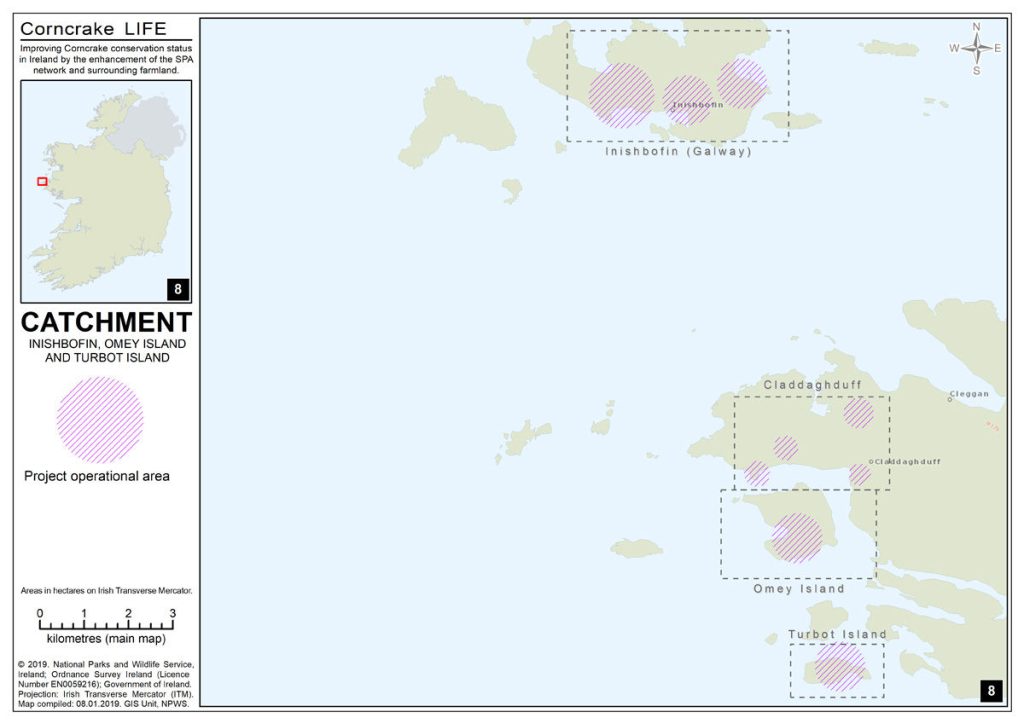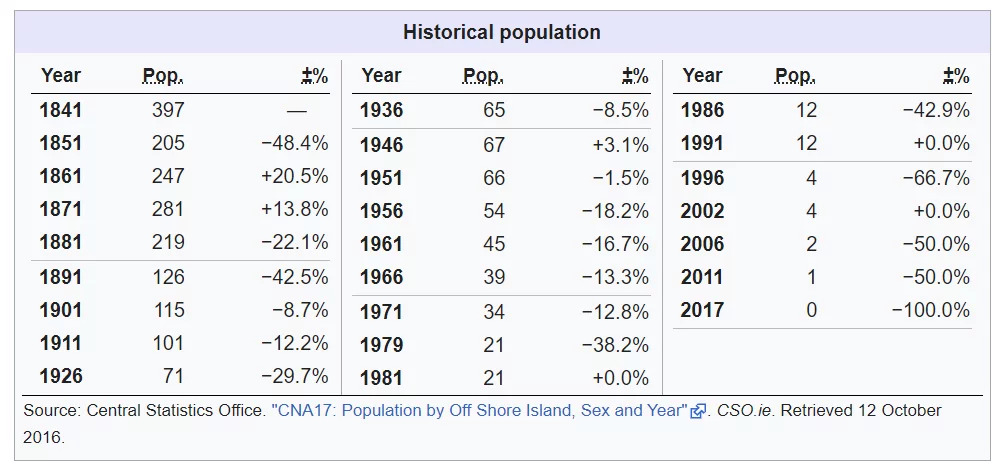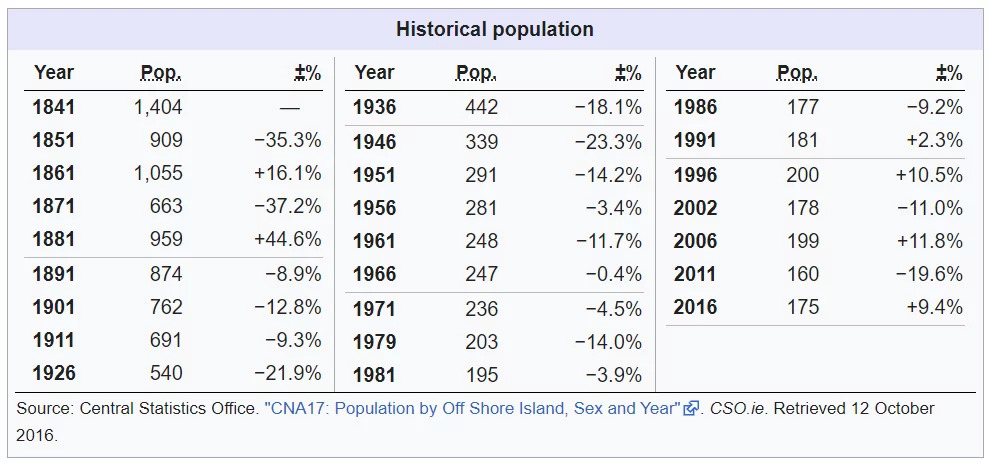
The Inishbofin, Omey and Turbot Island catchment has seen increases in the corncrake population in recent years. The birds are a popular tourist attraction and Inishbofin in particular has become a popular wildlife tourism destination.

Omey Island
Omey Island (Irish: Iomaidh) is a tidal island in Claddaghduff is accessible at low tide every day by crossing acres of firm sandy beach, either in a car or on foot. Simply follow the direction poles in the sand that mark the way across, but be sure to check the tide timetable beforehand as you will be stranded if the tide comes in! Omey Island has a wealth of antiquities. The ruins of Teampaill Féichín (Feichin’s Church), a medieval church built on a 7th century Christian settlement lie close to the north coast. The church was covered in sand until 1981 and it is surrounded by the remains of a semi-sunken village that was wiped out during the Famine. St. Feichin’s Holy Well can also be found to the west, just above a rocky inlet. The island is now largely abandoned, with some part-time residents during the summer months. It once supported a population of over four hundred souls. It is however the main burial ground for this region, utilizing an ancient burial ground associated with St Brendan.
Galway Tides (for Connemara add 5 minutes): www.sailing.ie/Racing/Tides/TidesGalway.aspx

Demographics
The table below reports data on Omey Island’s population taken from Discover the Islands of Ireland (Alex Ritsema, Collins Press, 1999) and the Census of Ireland.
The last permanent resident of the island, stuntman Pascal Whelan, died in February 2017 aged 75.
Inishbofin Island
The island’s English name “Inishbofin” is derived from the Irish Inis Bó Finne, or in plain language, the “Island of the White Cow”. The island measures only 5.7km by 4km and lies seven miles off Galway’s coast. The island is divided into five townlands, West Quarter, Fawnmore, Middle Quarter, Cloonamore and Knock.
In the year 668 Saint Colmán founded a monastery on Inishbofin, and it went on to survive until the 10th century. It is also home to the ruins of Cromwell’s barracks, constructed in 1652 at the entrance to the island’s harbour. During the terrible years of his campaigns, Inishbofin was transformed into a penal colony for Catholic clerics, and terrible atrocities were wreaked on the islanders and on the unfortunate clergymen he rounded up. One unfortunate bishop was tied to “Bishop’s Rock” at low tide, and slowly drowned in full sight of his fellow priests as the waters rose.
Inishbofin is home to “Dún Gráinne”, the remains of a fort used by the legendary Pirate Queen, Grace O’Malley. It is also home to a second Celtic fort which dates all the way back to 1000 B.C. The island is believed to have been continuously inhabited for up to 10,000 years.
Inishbofin is a SAC and a SPA. The island is a breeding area for many species of birds. The rarest or most threatened species breeding on the island at present are the Corncrake. The Corncrake have been nesting and breeding on Inishbofin for many years. For the adventurous there are exciting mountain walks, hill climbing and excellent shore angling. Inishbofin has become an important centre for traditional Irish music and song with its own Ceilí band. Inishbofin plays host to many visiting musicians and artists.
With its westerly position and its protected harbour, Inishbofin was one of the most important shipping havens on the West coast of Ireland in the days of sail. It was one of the last Royalist strongholds to fall to Cromwell’s army, and was garrisoned by them until the end of the century. In later years Cromwell’s forces used it as a staging post for Irish men and women who were being transported to the West Indies. During these years they cut down all the trees on the island for use as building materials and fuel. Because of the salt-enriched air, however, the trees were never able to re-establish themselves, and the island is bare of trees to this day.
Where to stay
Inishbofin has a wide choice of places to stay including self-catering holiday homes, guesthouses and B&B’s.
Things to do
- Inishbofin has 3 fabulous looped walks, all with stunning views of the Islands beautiful coastal cliffs, coves, harbour, and bathing spots. Enjoy.
- For such a small Island, Inishbofin has numerous beautiful beaches with crystal clear waters. An excellent place to spend the day to unwind. Several beaches on Inishbofin have been awarded the ‘green coast award’.
- With some of the clearest waters in Ireland, Inishbofin is an excellent place to dive and is popular for diving clubs.
- Inishbofin is a breeding area for many species of birds. The rarest or most threatened species breeding on the island at present is the Corncrake. Other species of bird found breeding of Inishbofin include Common Tern, Arctic Tern, Fulmers, Shags, Puffin, Guillemots, Common Gulls, greater and lesser Black Backed Gulls, Manx Shearwaters, Herring Gulls and Choughs.
- Many species of wild flowers can be seen on Inishbofin Island throughout the year. Possibly one of the best ways and times to see these flowers is to join Leo Hallisey’s Summer School which is run every year for two weeks in July. The Summer School is generally aimed at teachers wishing to catch up on extra-curricular activities.
- Seal colonies can be found in two areas on and around Inishbofin Island. The first one is based on the island near the Stags Rock. A second colony can be seen near the island of Inishgort that is situated approximately one mile West of Inishbofin Harbour. This colony can be accessed only by boat and this may be the reason that seals congregate in this area. The only visitors they receive are the fishermen setting and hauling their lobster pots.
Getting to Inishbofin
Inishbofin Island is accessed by way of ferry boat from Cleggan Harbour, located northwest of Clifden. There is a daily ferry service to Inishbofin all year round. There are three sailings daily to and from the island during the summer months and two sailings daily during the winter months.
Tickets can be booked online for the ferry.
T: +353 95 45819
Call or Text: 087 3667185
E: info@inishbofinislanddiscovery.com
W: www.inishbofinislanddiscovery.com

Demographics
The table below reports data on Inishbofin’s population taken from Discover the Islands of Ireland (Alex Ritsema, Collins Press, 1999) and the Census of Ireland. Censuses in Ireland before 1841 are not considered complete and/or reliable.
For more Maps and Tourist Information visit: http://www.irishislands.info
For more information on the Special Protection Area within this catchment, visit the National Parks and Wildlife Services website www.npws.ie/protected-sites/spa/004231
